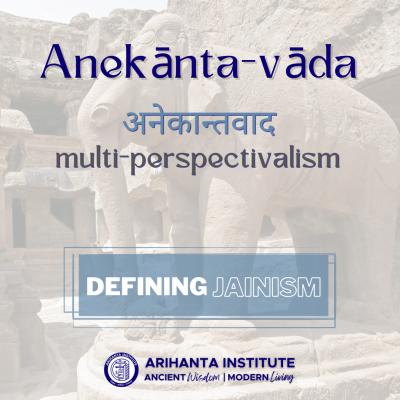
Gandhi’s relationship to religion was immensely complex. Both in his political approach to end religious conflict and in his own personal spiritual attempts to understand the divinity in the World’s traditions, he sought to find equal value in all traditions, seeking constantly to reconcile the seemingly irreconcilable differences between them. He was clear that belief and faith in God was absolutely essential to being a Satyagrahi[1] and even admitted that Buddhist and Jain doctrines would be disqualified from Satyagraha if they did not admit the existence of God, which amounts to an acknowledgement about the non-theistic nature of these doctrines. However, he seems to be quite flexible with his definition of “God” in a way that perhaps allows for Jain and Buddhist non-monotheism that acknowledges “Supreme Power or some Being even indefinable” as legitimate versions of a Satyagrahi’s “ultimate mainstay”[2] (Gandhi 2001, 364, Harijan, 3-6-‘39).
His allowance for Jain theology to be rightly considered “godly” is evident in his words about Śrīmad Rājcandra, the famous Jain guru who was only a couple of years his senior. Gandhi describes the “centre round which his [Śrīmad’s] life revolves” as the “the passion to see God face to face” and was impressed by Śrīmad’s absorption “in godly pursuits in the midst of business” and he notes that “[i]n my moments of spiritual crisis, therefore, he was my refuge” (Gandhi 1993, 88-89). Thus, when he writes that “[b]elief in one God is the corner-stone of all religions” (Gandhi 1972, 55, Harijan, February 2, 1934) this does not disqualify Jainism from being included when he says that “Religions are different roads converging to the same point” and this type of statement is consistent with Jainism since “If a man reaches the heart of his own religion, he has reached the heart of the others too” (Gandhi 1972, 54, Indian Home Rule, 1909).
But one still must make sense of the contradictory nature of religious claims. Either monotheism is true, or it isn’t, and Jains are not monotheists. How can we do this and preserve the equal value of other traditions? Gandhi does this by moving towards what appears to be similar to Jain Anekānta-vāda when he notes that “(1) all religions are true; [and] (2) all religions have some error in them,” concluding therefore that “[m]y own veneration for other faiths is the same as that for my own faith” (Gandhi 1972, 54, Report of the First Annual Meeting of International Fellowships, Sabarmati, 1928).
Moreover, he explicitly employs Jain teachings to display his comfort with the seemingly contradictory nature of conflicting religious truth claims, a harmonization which is necessary for the broader social project of Indian Independence and surmising the spiritual veracity within all the World’s traditions. He writes,
“I am [Hindu] Advaitist and yet I can support [Hindu] Dvaitism (dualism) [two schools generally seen to be polemic contradictions of each other]. The world is changing every moment, and is therefore unreal, it has no permanent existence. But though it is constantly changing, it has something about it which persists, and it is therefore to that extent real. I have therefore no objection to calling it real and unreal, and thus being called an anekantavadi or a syadvadi” (Gandhi 2015, 13-14, Young India, 21-1-‘26)
Gandhi, much like many Jains today, employed Anekānta-vāda as a sort of intellectual ahiṃsā because it allowed him to move a position of resentment for “the ignorance of my opponents” to a position of loving them “because I am gifted with the eye to see myself as others me and vice versa” such that he can allow the “whole world in the embrace of my love.” For him “Anekantavad is the result of the twin doctrine of Satyagraha and Ahimsa.” Thus, by invoking Anekānta-vāda, he can accept the seemingly contradiction positions of Advaita and Dvaita Vedāntas, from this “doctrine of the manyness of reality” he can accept the version of reality “[f]rom the platform of the Jains [from which] I prove the non-creative aspect of God, and from that of Ramanuga [the Hindu Vedāntist] the creative aspect.” Anekānta-vāda leads him to the harmonious conclusions that “we are all thinking of the Unthinkable, describing the Indescribable, seeking to know the Unknown, and that is why our speech falters, is inadequate, and even often contradictory” (Gandhi 2015, 13-14, Young India, 21-1-‘26). For Gandhi, this conciliatory approach to religious pluralism embodied by Jain Anekānta-vāda was essential to quell interreligious violence and to allowing one to broaden the scope of one’s religious inquiry to realize the “fundamental truth of all great religions of the world” (Gandhi 2015, 55; Harijan, February 16, 1934).
[1]“For a Satyagrahi has no other stay but God, and he who has any other stay or depends on any other help cannot offer Satyagraha. He may be a passive resister, non-co-operator and so on, but not a true Satyagrahi. (Gandhi 2001, 363)
[2] “‘What about the Buddhists and Jains then?’ someone has asked. Well, I will say that if the Buddhists and Jains raise this objection themselves, and say that they would be disqualified if such a strict rule were observed, I should say to them that I agree with them. But far be it from me to suggest that you should believe in the God that I believe in. Maybe your definition is different form mine, but your belief in that God must be your ultimate mainstay. It may be some Supreme Power or some Being even indefinable, but belief in it is indispensable. To Bear all kinds of tortures without a murmur of resentment is impossible for a human being without the strength that comes from God. Only in His strength we are strong. And only those who can cast their cares and their fears on that immeasurable Power have faith in God” (Gandhi 2001, 364).

